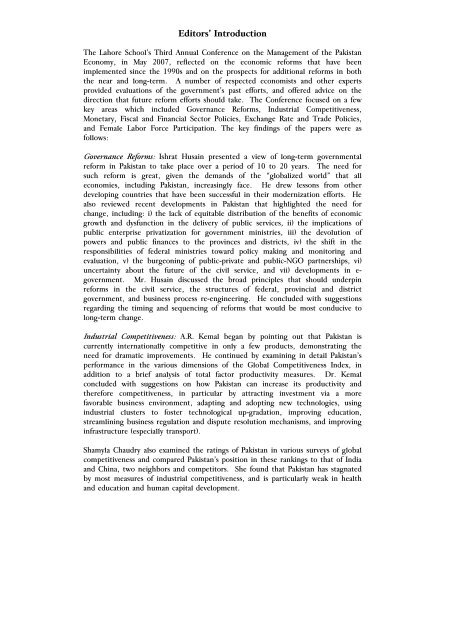Special Edition-07.pdf - Lahore School of Economics
Special Edition-07.pdf - Lahore School of Economics
Special Edition-07.pdf - Lahore School of Economics
Create successful ePaper yourself
Turn your PDF publications into a flip-book with our unique Google optimized e-Paper software.
Editors’ Introduction<br />
The <strong>Lahore</strong> <strong>School</strong>’s Third Annual Conference on the Management <strong>of</strong> the Pakistan<br />
Economy, in May 2007, reflected on the economic reforms that have been<br />
implemented since the 1990s and on the prospects for additional reforms in both<br />
the near and long-term. A number <strong>of</strong> respected economists and other experts<br />
provided evaluations <strong>of</strong> the government’s past efforts, and <strong>of</strong>fered advice on the<br />
direction that future reform efforts should take. The Conference focused on a few<br />
key areas which included Governance Reforms, Industrial Competitiveness,<br />
Monetary, Fiscal and Financial Sector Policies, Exchange Rate and Trade Policies,<br />
and Female Labor Force Participation. The key findings <strong>of</strong> the papers were as<br />
follows:<br />
Governance Reforms: Ishrat Husain presented a view <strong>of</strong> long-term governmental<br />
reform in Pakistan to take place over a period <strong>of</strong> 10 to 20 years. The need for<br />
such reform is great, given the demands <strong>of</strong> the “globalized world” that all<br />
economies, including Pakistan, increasingly face. He drew lessons from other<br />
developing countries that have been successful in their modernization efforts. He<br />
also reviewed recent developments in Pakistan that highlighted the need for<br />
change, including: i) the lack <strong>of</strong> equitable distribution <strong>of</strong> the benefits <strong>of</strong> economic<br />
growth and dysfunction in the delivery <strong>of</strong> public services, ii) the implications <strong>of</strong><br />
public enterprise privatization for government ministries, iii) the devolution <strong>of</strong><br />
powers and public finances to the provinces and districts, iv) the shift in the<br />
responsibilities <strong>of</strong> federal ministries toward policy making and monitoring and<br />
evaluation, v) the burgeoning <strong>of</strong> public-private and public-NGO partnerships, vi)<br />
uncertainty about the future <strong>of</strong> the civil service, and vii) developments in e-<br />
government. Mr. Husain discussed the broad principles that should underpin<br />
reforms in the civil service, the structures <strong>of</strong> federal, provincial and district<br />
government, and business process re-engineering. He concluded with suggestions<br />
regarding the timing and sequencing <strong>of</strong> reforms that would be most conducive to<br />
long-term change.<br />
Industrial Competitiveness: A.R. Kemal began by pointing out that Pakistan is<br />
currently internationally competitive in only a few products, demonstrating the<br />
need for dramatic improvements. He continued by examining in detail Pakistan’s<br />
performance in the various dimensions <strong>of</strong> the Global Competitiveness Index, in<br />
addition to a brief analysis <strong>of</strong> total factor productivity measures. Dr. Kemal<br />
concluded with suggestions on how Pakistan can increase its productivity and<br />
therefore competitiveness, in particular by attracting investment via a more<br />
favorable business environment, adapting and adopting new technologies, using<br />
industrial clusters to foster technological up-gradation, improving education,<br />
streamlining business regulation and dispute resolution mechanisms, and improving<br />
infrastructure (especially transport).<br />
Shamyla Chaudry also examined the ratings <strong>of</strong> Pakistan in various surveys <strong>of</strong> global<br />
competitiveness and compared Pakistan’s position in these rankings to that <strong>of</strong> India<br />
and China, two neighbors and competitors. She found that Pakistan has stagnated<br />
by most measures <strong>of</strong> industrial competitiveness, and is particularly weak in health<br />
and education and human capital development.

















